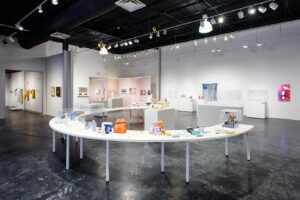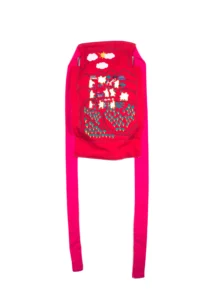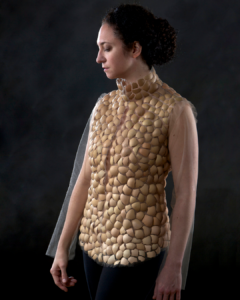May Howard reviews Designing Motherhood, a timely exhibition on the material history of human reproduction at Houston Center of Contemporary Craft, Houston.
By May Howard

There is something to be said about exhibitions that miraculously emerge at the right place and time. Designing Motherhood: Things That Make and Break Our Births at the Houston Center for Contemporary Craft (HCCC) presents an expansive material history of human reproduction. With over sixty objects of craft and design with additions by more than twenty contemporary artists, Designing Motherhood interrogates the politics behind who designed what, how, why, and for whom. By re-indexing the objects, practices, and infrastructures of the reproductive arc, this exhibition allows for a multidimensional definition of motherhood, recognizing how “mother” operates as a verb, noun, identity, and political category.
Designing Motherhood is conceived by a team of design curators and scholars including Juliana Rowan Barton, Michelle Millar Fisher, and Amber Winick; artist and arts administrator Zoë Greggs; and advisors from the Maternity Care Coalition in Philadelphia. It was first exhibited at the Mütter Museum and the Center for Architecture and Design in 2021 before traveling to venues in Boston, Seattle, and Stockholm. Now in its fifth iteration, the HCCC’s adaptation is unique in its focus on the relationship between caregiving and craftwork. The exhibition opens with a textile-rich installation that explores vessels of life and care: from baby carriers and blankets to the body itself. Curtains of varying pink shades encircle the walls, visually conjuring a womb or hospital room. One may recognize a suspended and neatly folded white cotton textile with alternating blue and pink stripes as the ubiquitous Kuddle-Up Blanket. Created during the mid-century in concert with the developing medical garments industry, it is the hallmark receiving blanket in hospitals today. Included, too, is the Snugli (the first mass-produced baby carrier in the US), which exploded in popularity in the 1960s due to its convenience, comfort, and hands-free design.

Emerson Croft’s Earth Baby Blanket (2021) shows how the handmade can intervene in the social apparatus of industrial design. The complexity of weave and nuances of green and gray in Croft’s textile represent a deeper intricacy of our social and cultural fabric that challenge conventions of gender encoded in the rigid colored striping of the Kuddle-Up Blanket. Indigenous baby carriers feature as well, including Sue Rigdon’s Cradleboard (1995), Tanya White’s photograph of a wahakura (2022), and Ger Xiong/Ntxawg Xyooj’s daim nyias (2021). Each demonstrates the diversity and ingenuity of Indigenous design histories while highlighting traditional craft technologies. In My Belly (2021) from the series My Black Body by Alison Croney Moses, the exposed disjointed seams, contrasting grains and progressive tones of wood express the physical and spiritual shape-shifting that occurs through pregnancy. Poetically rendered in cedarwood and milk paint, motherhood is made metamorphic like the wood she wields.

Among the many contemporary artists, the breast pump emerges as a typology of interest. The design trajectory of the device is visually charted with early mechanical models like Einar Egnell’s Egnell SMB Breast Pump, (c. 1956)—the result of a collaborative relationship with Sister Maja Kindberg to improve breast pumps in Stockholm hospitals—to the tube-and-cordless Willow Wireless Breast Pump (2021) that offers an accompanying mobile app. In Chromed Life (Machine Pulled) (2020), Aimee Koran uses alluringly bright red chrome-plated breast pumps to call attention to the hidden labor behind their use and the economic value of milk production. Works included by artists Ani Liu, Sara Hubbs, and Aimee Gilmore utilize milk as an artistic medium to drive their formal and ideological investigations.
Designing Motherhood attends to the systems of discrimination and domination that constitute this maternal material world as it is understood today.1 The exhibition sheds light on the inhumane processes behind the technological advancements of tools like the speculum, and the distressing consequences of failed designs like the Dalkon Shield IUD. Dr. J. Marion Sims perfected his speculum design while seeking a treatment for vesicovaginal fistula by performing experimental surgical procedures on at least twelve unconsenting enslaved Black women between 1845 and 1849 without anesthetics. The Dalkon Shield, invented in 1968 by Dr. Hugh Davis and Irwin Lerner, led to over 300,000 filed claims and eighteen reported deaths due to severe uterine perforations and pelvic infections caused by the multifilament wick.2 This incident led to widespread mistrust of IUDs as a form of birth control in the US and prompted the FDA to regulate their safety and efficacy.

With the political suppression of reproductive sovereignty, exhibitions such as this one are vital, especially in Texas, which is among the lowest-ranking states in reproductive health coverage, access and affordability as well as healthcare quality and prevention.3 These are matters of life and death. Designing Motherhood at the HCCC is admirable in its traversal of educational and activist registers. Even so, a more articulated presentation of maternal mortality and postpartum depression as they intersect with race and class would further contribute to the breadth of experiences of motherhood.4 A concentrated history of midwifery would engender much interest, for there are rich stories to elucidate of Indigenous and Black midwives who, for generations, cultivated infrastructures of home-based healthcare to serve women across the US South.
Toward the exhibition’s conclusion is a charming and intimate portrait of a mother breastfeeding her child captured in swaths of gestural paint. Mother and Child (1996) by Patti Lou Richardson is an ode to the artist’s daughter, Regá Richardson Waggett who was integral in drafting and passing the first breastfeeding law in Texas after witnessing a nursing mother forced to leave a Houston museum. This portrait is a reminder of how everyday refusals and acts of resistance, like Regá’s, can lead to critical change.
1] See Hill Collins, Patricia. Black Feminist Thought: Knowledge, Consciousness, and the Politics of Empowerment. 30th anniversary edition. New York: Routledge, 2022.
[3] “New Scorecard Offers State-by-State Ranking of Women’s Health and Reproductive Care,” The Commonwealth Fund, July 18, 2024. Accessed November 26, 2024. https://www.commonwealthfund.org/press-release/2024/new-scorecard-offers-state-state-ranking-womens-health-and-reproductive-care
[4] “Insights into the U.S. Maternal Mortality Crisis: An International Comparison,” The Commonwealth Fund, June 4, 2024. Accessed November 26, 2024. ttps://www.commonwealthfund.org/publications/issue-briefs/2024/jun/insights-us-maternal-mortality-crisis-international-comparison

